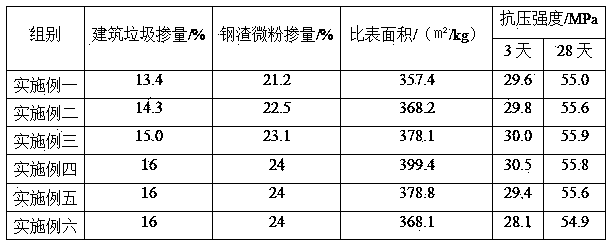Method for producing green ecological cement resistant to seawater corrosion by using construction wastes
A technology of construction waste and ecological cement, which is applied in the field of green ecological cement that uses construction waste to produce anti-seawater corrosion, can solve the problems of inconvenient construction and engineering quality control, lack of uniform standards for preparation technology, unfavorable production and construction costs, etc., and achieve good results. Compactness and volume stability, good economic and social benefits, and low price
- Summary
- Abstract
- Description
- Claims
- Application Information
AI Technical Summary
Problems solved by technology
Method used
Image
Examples
Embodiment 1
[0036] The green ecological cement that resists seawater corrosion is produced with construction waste, and its production method comprises the following steps:
[0037] a. Drying: The construction waste is conveyed by the belt to the vertical dryer for drying, and the water content in the grinding is 1.48%. The steel slag fine powder is sent to the rotary dryer by the belt conveyor for drying. After drying, the steel slag is passed through the elevator. Sent to the steel slag warehouse for storage, the water content is 2.8%;
[0038] b. Grinding: Grind the dry construction waste and steel slag micropowder with a cement mill respectively, so that the passing rate through a 100 mesh sieve reaches more than 95%, prepare 5 parts of construction waste and 20 parts of steel slag micropowder and prepare Add 40 parts of sulphoaluminate cement clinker, 0.06 composite activator and 2 parts of early strength agent into the cement mill, spray atomized water to the inside of the cement mi...
Embodiment 2
[0042] The green ecological cement that resists seawater corrosion is produced with construction waste, and its production method comprises the following steps:
[0043] a. Drying: The construction waste is conveyed by the belt to the vertical dryer for drying, and the water content in the grinding is 1.48%. The steel slag fine powder is sent to the rotary dryer by the belt conveyor for drying. After drying, the steel slag is passed through the elevator. Sent to the steel slag warehouse for storage, the water content is 2.8%;
[0044] b. Grinding: Grind the dry construction waste and steel slag micropowder with cement mill respectively, so that the passing rate of it through a 100 mesh sieve reaches more than 95%, prepare 20 parts of construction waste and 25 parts of steel slag micropowder and prepare Add 50 parts of sulphoaluminate cement clinker, 0.08 composite activator and 5 parts of early strength agent into the cement mill, spray atomized water to the inside of the ceme...
Embodiment 3
[0048] The green ecological cement that resists seawater corrosion is produced with construction waste, and its production method comprises the following steps:
[0049] a. Drying: The construction waste is conveyed by the belt to the vertical dryer for drying, and the water content in the grinding is 1.48%. The steel slag fine powder is sent to the rotary dryer by the belt conveyor for drying. After drying, the steel slag is passed through the elevator. Sent to the steel slag warehouse for storage, the water content is 2.8%;
[0050] b. Grinding: Grind the dry construction waste and steel slag micropowder with a cement mill respectively, so that the passing rate through a 100 mesh sieve reaches more than 95%, and prepare 13 parts of construction waste and 23 parts of steel slag micropowder obtained Add 45 parts of sulphoaluminate cement clinker, 0.07 composite activator and 4 parts of early strength agent into the cement mill, spray atomized water to the inside of the cement ...
PUM
 Login to View More
Login to View More Abstract
Description
Claims
Application Information
 Login to View More
Login to View More - R&D
- Intellectual Property
- Life Sciences
- Materials
- Tech Scout
- Unparalleled Data Quality
- Higher Quality Content
- 60% Fewer Hallucinations
Browse by: Latest US Patents, China's latest patents, Technical Efficacy Thesaurus, Application Domain, Technology Topic, Popular Technical Reports.
© 2025 PatSnap. All rights reserved.Legal|Privacy policy|Modern Slavery Act Transparency Statement|Sitemap|About US| Contact US: help@patsnap.com

